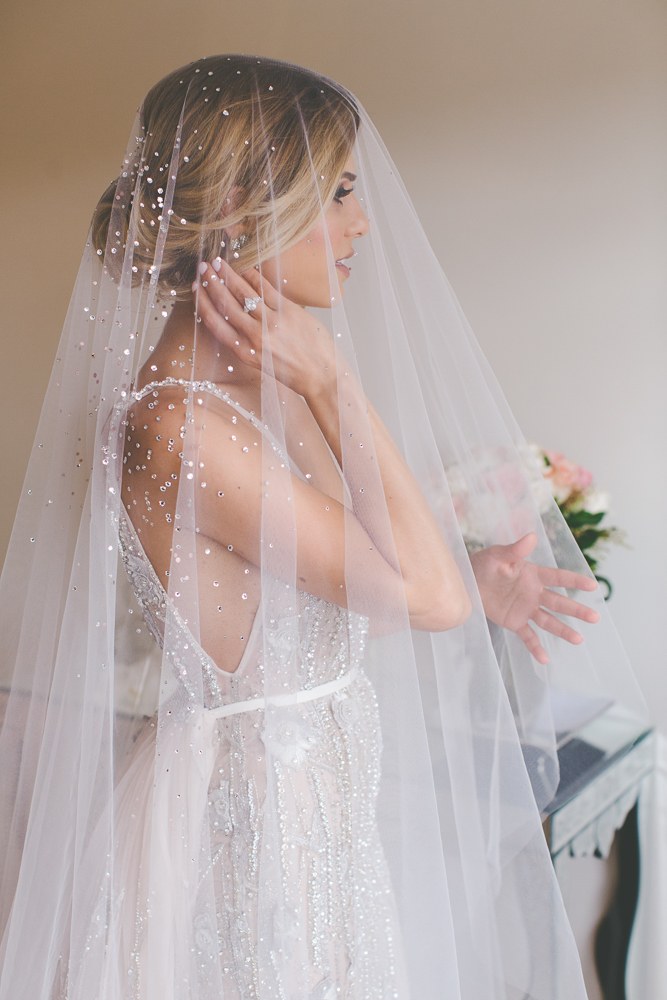Every bride-to-be wants to look and feel her gorgeous best on her wedding day. The veil along with other hair accessories for weddings can complement and accentuate your wedding gown. It is also going to give your silhouette and bridal attire the extra touch as you walk down the aisle.
It is important that you choose your veil only after you’ve decided on your style of gown, failing which you could end up with a totally mismatched headpiece for your gown. You should also already have in mind how you intend to wear your hair on the big day because your veil should suit your hairdo. Birdcages and blushers go with almost any hairstyle but that’s not the case with all styles of veils. Your hairstyle would also influence where your veil is placed and how it is secured.
Your Choices by Length
You may have to test out different options alongside your first dress fitting to get the best option for your wedding style and theme.
- Birdcage – The birdcage or bandeau veil is a short veil ideal for the quirky bride or for a retro 50’s wedding style. Typically made of lace or net, the veil may cover only the eyes, both eyes and nose or the whole face falling at the jaw line. This is a great veil for the beach if you’re worried about your veil blowing about with the wind.
- Blusher – A blusher veil hangs over the face and stops at the shoulders near the top of the gown. At the altar, the groom can pull back this veil to see his beautiful bride and give her a kiss.
- Elbow length Veil – This length of veil is suitable for those looking for some more coverage, flowing as it does down the shoulders. Elegant is the best way to describe this veil which is fantastic for a ball gown as the veil culminates at the area where the skirt’s fullness starts.
- Fingertip – As the name indicates, a fingertip veil falls further down the bride’s hips, usually at the fingertips when the bride’s arms are at her sides. Onlookers would be able to view intricate designs on the back of the wedding gown through the veil’s sheer fabric. Short women should avoid this veil as it may make them look shorter.
- Knee length – The knee-length veil is a combination of elegance and drama and is suitable for a fitted gown that doesn’t have a train. If your gown has beautiful detailing on the bodice and waist, this veil would go well with it.
- Waltz or ballet length – This veil ends above the ankle but below the calf of the bride’s legs. It puts across the impression of ethereal and romantic.
- Chapel length – If you’re looking for something more traditional and formal, this is it. The veil extends to a few inches further from the hemline or train. It sweeps across the floor but doesn’t need any bothersome bustling.
- Cathedral length – This is the longest available veil length. It is a great choice for women who want to feel like a princess or make a royal entrance. Of course adorning this veil would require assistance to straighten and spread out the trailing veil which would extend considerably beyond the hem.
Material
Tulle is the typical fabric of choice for veils though there are also alternatives such as lace, satin and silk. Tulle is lighter and retains its shape better than satin or silk which tend to hang straight and look heavy.
Vintage Veils
Want to convert your plain dress into a splendid wedding statement? Why not try a vintage wedding veil. What’s more, the belief is that such a veil can bring good luck to the wearer.
Perhaps you already have a veil handed down by a family elder to you. In such a situation, it is better to choose a gown to match the veil rather than the other way around.
The birdcage veil discussed earlier is one type of vintage veil. Here are a few others that you can consider.
- Juliet Cap veil – This veil which had its origins in the 16th century was made popular in the 1920s. It is worn tightly fitted to the head and low on the brow and kept in place using either a crown of flowers or an embellished bandeau. For a rustic theme wedding, a Juliet Cap veil is a good choice.
- Mantilla veil – It originates from 17th century Spain and is characterized by an almost body-hugging circular shape and wide lace edging. Pins or a comb are used to attach the veil. This veil is suitable for only low updos and loose hair so avoid it if you are planning a sleek chignon or ballerina bun.
Lastly, if you are having a modern-theme wedding, you could consider a wedding cape veil. A tulle wedding cape veil impresses by its uniqueness while also functioning as a cover-up.











